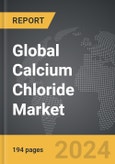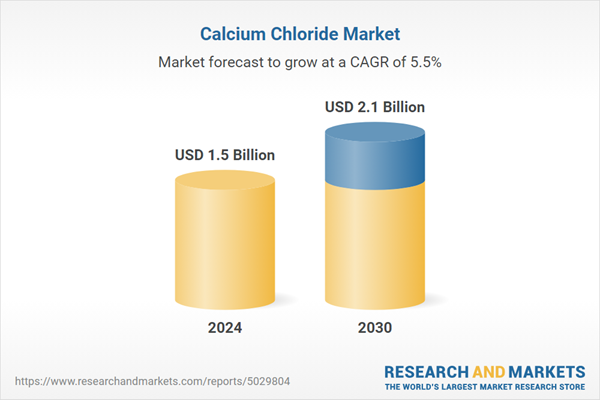The global market for Calcium Chloride was valued at US$1.5 Billion in 2024 and is projected to reach US$2.1 Billion by 2030, growing at a CAGR of 5.5% from 2024 to 2030. This comprehensive report provides an in-depth analysis of market trends, drivers, and forecasts, helping you make informed business decisions. The report includes the most recent global tariff developments and how they impact the Calcium Chloride market.
Segments: Application (De-Icing, Dust Control, Drilling Fluids, Construction, Industrial Processing, Other Applications).
Geographic Regions/Countries: World; United States; Canada; Japan; China; Europe (France; Germany; Italy; United Kingdom; Spain; Russia; and Rest of Europe); Asia-Pacific (Australia; India; South Korea; and Rest of Asia-Pacific); Latin America (Argentina; Brazil; Mexico; and Rest of Latin America); Middle East (Iran; Israel; Saudi Arabia; United Arab Emirates; and Rest of Middle East); and Africa.
The analysts continuously track trade developments worldwide, drawing insights from leading global economists and over 200 industry and policy institutions, including think tanks, trade organizations, and national economic advisory bodies. This intelligence is integrated into forecasting models to provide timely, data-driven analysis of emerging risks and opportunities.
Global Calcium Chloride Market - Key Trends and Drivers Summarized
Why Is Calcium Chloride So Widely Used?
Calcium chloride (CaCl2) is a highly versatile chemical compound known for its ability to attract and retain moisture, making it useful across a broad spectrum of applications in both industrial and environmental settings. It is a salt of calcium and chlorine, typically produced by combining limestone and hydrochloric acid or as a byproduct of the Solvay process, which is used to produce sodium carbonate. Calcium chloride’s hygroscopic nature allows it to absorb moisture from its surroundings, making it particularly effective as a desiccant and de-icing agent. In cold climates, calcium chloride is widely used for snow and ice control on roads, sidewalks, and parking lots, as it works more effectively than other salts at lower temperatures. Additionally, calcium chloride is used in water treatment, food preservation, concrete additives, and even in the oil and gas industry, where it serves as a key component in drilling fluids. Its wide-ranging utility makes calcium chloride an essential compound in multiple industries, helping to ensure safety, efficiency, and environmental management.How Does Calcium Chloride Serve Diverse Industrial Needs?
Calcium chloride’s utility spans numerous industries, offering unique benefits based on its chemical properties. In the construction industry, calcium chloride is commonly used as a concrete additive, where it accelerates the curing process, allowing construction projects to progress faster, especially in cold weather. This property is particularly beneficial in large-scale infrastructure projects where weather conditions might otherwise cause delays. In the oil and gas sector, calcium chloride is a critical component of drilling fluids used in well drilling operations. It helps to stabilize the wellbore, control pressure, and prevent water from entering the well, which improves the overall efficiency of drilling processes. Moreover, calcium chloride’s moisture-absorbing abilities make it an effective desiccant in industrial dehumidification processes and food preservation, where it is used to control humidity levels and extend the shelf life of products. Beyond these uses, it is also utilized in water treatment plants to adjust calcium hardness and improve water quality. Its versatility across sectors such as construction, energy, food processing, and environmental management underlines its significance as a multi-purpose compound essential to modern industries.What Are the Technological and Environmental Considerations in Calcium Chloride Applications?
Recent advancements in technology and an increasing focus on environmental sustainability have brought new innovations to the production and use of calcium chloride. One key area of development is in the environmental management sector, where calcium chloride’s use as a dust suppressant has gained prominence. Applied to unpaved roads and mining sites, calcium chloride reduces dust generation by binding particles together and retaining moisture, which improves air quality and reduces health risks in dusty environments. In road de-icing, innovations in calcium chloride-based products have led to the creation of pre-treated and liquid formulations that are more effective and environmentally friendly than traditional rock salt. These advanced de-icing agents work at lower temperatures and reduce the overall amount of chemicals required, lessening the environmental impact of road treatment. In industrial settings, calcium chloride has also been integrated into closed-loop systems in dehumidification processes, increasing energy efficiency by recycling moisture-absorbing capabilities. Furthermore, efforts are being made to optimize the production process of calcium chloride to reduce energy consumption and minimize waste. With a growing emphasis on sustainability and environmental responsibility, these technological advancements are ensuring that calcium chloride continues to meet industrial needs while addressing environmental concerns.What Is Driving the Growth of the Calcium Chloride Market?
The growth in the calcium chloride market is driven by several factors related to its expanding applications in industrial processes, environmental management, and consumer demand. One of the most significant drivers is the increased need for effective de-icing solutions, particularly in regions with harsh winter conditions. As climate variability leads to more severe and unpredictable winter weather, municipalities and businesses are relying more heavily on calcium chloride for efficient snow and ice removal, as it performs better in lower temperatures than traditional sodium chloride. Additionally, the construction industry’s growing demand for fast-setting concrete additives, especially in countries with ongoing infrastructure development, is boosting the need for calcium chloride in building projects. The oil and gas industry’s continued expansion, particularly in shale and offshore drilling, is another major factor, as calcium chloride is an essential component in drilling fluids and well completion operations. Moreover, the agricultural sector’s adoption of calcium chloride as a soil conditioner and dust suppressant in farming regions experiencing drought conditions is adding to market demand. Increased awareness of the environmental benefits of calcium chloride, such as its effectiveness in dust control and water treatment, further contributes to its market growth. As industries seek solutions that balance performance with environmental impact, calcium chloride’s role in diverse sectors ensures its steady expansion in the global market.Report Scope
The report analyzes the Calcium Chloride market, presented in terms of units. The analysis covers the key segments and geographic regions outlined below.Segments: Application (De-Icing, Dust Control, Drilling Fluids, Construction, Industrial Processing, Other Applications).
Geographic Regions/Countries: World; United States; Canada; Japan; China; Europe (France; Germany; Italy; United Kingdom; Spain; Russia; and Rest of Europe); Asia-Pacific (Australia; India; South Korea; and Rest of Asia-Pacific); Latin America (Argentina; Brazil; Mexico; and Rest of Latin America); Middle East (Iran; Israel; Saudi Arabia; United Arab Emirates; and Rest of Middle East); and Africa.
Key Insights:
- Market Growth: Understand the significant growth trajectory of the De-icing Application segment, which is expected to reach US$831.6 Million by 2030 with a CAGR of a 6.1%. The Dust Control Application segment is also set to grow at 5.2% CAGR over the analysis period.
- Regional Analysis: Gain insights into the U.S. market, valued at $391.5 Million in 2024, and China, forecasted to grow at an impressive 8.6% CAGR to reach $485.1 Million by 2030. Discover growth trends in other key regions, including Japan, Canada, Germany, and the Asia-Pacific.
Why You Should Buy This Report:
- Detailed Market Analysis: Access a thorough analysis of the Global Calcium Chloride Market, covering all major geographic regions and market segments.
- Competitive Insights: Get an overview of the competitive landscape, including the market presence of major players across different geographies.
- Future Trends and Drivers: Understand the key trends and drivers shaping the future of the Global Calcium Chloride Market.
- Actionable Insights: Benefit from actionable insights that can help you identify new revenue opportunities and make strategic business decisions.
Key Questions Answered:
- How is the Global Calcium Chloride Market expected to evolve by 2030?
- What are the main drivers and restraints affecting the market?
- Which market segments will grow the most over the forecast period?
- How will market shares for different regions and segments change by 2030?
- Who are the leading players in the market, and what are their prospects?
Report Features:
- Comprehensive Market Data: Independent analysis of annual sales and market forecasts in US$ Million from 2024 to 2030.
- In-Depth Regional Analysis: Detailed insights into key markets, including the U.S., China, Japan, Canada, Europe, Asia-Pacific, Latin America, Middle East, and Africa.
- Company Profiles: Coverage of players such as Auro Chemical Industries Pvt. Ltd., Nedmag B.V., Occidental Chemical Corporation (Oxychem), Sameer Chemicals, Sitara Chemical Industries Ltd. and more.
- Complimentary Updates: Receive free report updates for one year to keep you informed of the latest market developments.
Some of the 42 companies featured in this Calcium Chloride market report include:
- Auro Chemical Industries Pvt. Ltd.
- Nedmag B.V.
- Occidental Chemical Corporation (Oxychem)
- Sameer Chemicals
- Sitara Chemical Industries Ltd.
- Solvay SA
- Sulaksh Chemiclas
- Tangshan Sanyou Chemical Industries Co., Ltd.
- Tetra Technologies, Inc.
- Ward Chemical, Ltd.
- Weifang Haibin Chemical Co., Ltd.
- Zirax Limited
Tariff Impact Analysis: Key Insights for 2025
Global tariff negotiations across 180+ countries are reshaping supply chains, costs, and competitiveness. This report reflects the latest developments as of April 2025 and incorporates forward-looking insights into the market outlook.The analysts continuously track trade developments worldwide, drawing insights from leading global economists and over 200 industry and policy institutions, including think tanks, trade organizations, and national economic advisory bodies. This intelligence is integrated into forecasting models to provide timely, data-driven analysis of emerging risks and opportunities.
What’s Included in This Edition:
- Tariff-adjusted market forecasts by region and segment
- Analysis of cost and supply chain implications by sourcing and trade exposure
- Strategic insights into geographic shifts
Buyers receive a free July 2025 update with:
- Finalized tariff impacts and new trade agreement effects
- Updated projections reflecting global sourcing and cost shifts
- Expanded country-specific coverage across the industry
Table of Contents
I. METHODOLOGYII. EXECUTIVE SUMMARY2. FOCUS ON SELECT PLAYERSIII. MARKET ANALYSISSOUTH KOREAREST OF ASIA-PACIFICARGENTINABRAZILMEXICOREST OF LATIN AMERICAIRANISRAELSAUDI ARABIAUNITED ARAB EMIRATESREST OF MIDDLE EASTIV. COMPETITION
1. MARKET OVERVIEW
3. MARKET TRENDS & DRIVERS
4. GLOBAL MARKET PERSPECTIVE
UNITED STATES
CANADA
JAPAN
CHINA
EUROPE
FRANCE
GERMANY
ITALY
UNITED KINGDOM
SPAIN
RUSSIA
REST OF EUROPE
ASIA-PACIFIC
AUSTRALIA
INDIA
LATIN AMERICA
MIDDLE EAST
AFRICA
Companies Mentioned (Partial List)
A selection of companies mentioned in this report includes, but is not limited to:
- Auro Chemical Industries Pvt. Ltd.
- Nedmag B.V.
- Occidental Chemical Corporation (Oxychem)
- Sameer Chemicals
- Sitara Chemical Industries Ltd.
- Solvay SA
- Sulaksh Chemiclas
- Tangshan Sanyou Chemical Industries Co., Ltd.
- Tetra Technologies, Inc.
- Ward Chemical, Ltd.
- Weifang Haibin Chemical Co., Ltd.
- Zirax Limited
Table Information
| Report Attribute | Details |
|---|---|
| No. of Pages | 194 |
| Published | April 2025 |
| Forecast Period | 2024 - 2030 |
| Estimated Market Value ( USD | $ 1.5 Billion |
| Forecasted Market Value ( USD | $ 2.1 Billion |
| Compound Annual Growth Rate | 5.5% |
| Regions Covered | Global |









